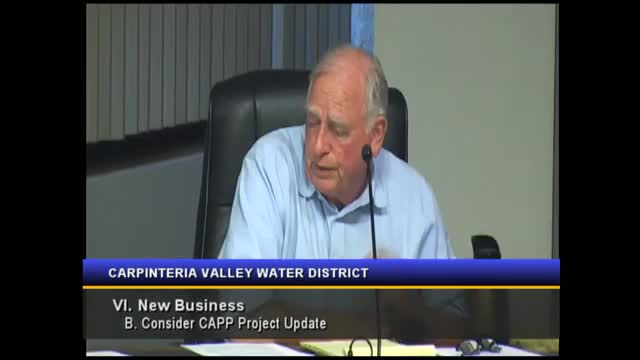Hillary Houser highlights groundwater recharge project amid funding challenges in California
April 25, 2024 | Carpinteria City, Santa Barbara County, California

This article was created by AI summarizing key points discussed. AI makes mistakes, so for full details and context, please refer to the video of the full meeting. Please report any errors so we can fix them. Report an error »

During a recent meeting of the Carpinteria Valley Water District, discussions highlighted the challenges and opportunities surrounding water management in the region. The meeting, held on April 24, 2024, focused on the potential for groundwater recharge projects amid California's ongoing budget constraints.
One significant topic raised was the possibility of reclassifying existing projects from recycling to groundwater recharge. This shift could open new avenues for funding, although participants acknowledged that California's current financial situation complicates matters. The conversation revealed a sense of urgency among board members and community stakeholders to explore innovative solutions for water sustainability.
Hillary Houser from Heal the Ocean provided a poignant perspective on the difficulties of securing funding for water-related projects. She recounted her organization's experience with a grant that was unexpectedly rescinded due to budget cuts, emphasizing the unpredictability of state funding. Houser's comments underscored the importance of proactive planning and the need for reliable financial support to advance water initiatives.
The meeting also touched on the unique advantages of Carpinteria's groundwater basin, which is noted for its capacity to support injection projects. This characteristic positions the area favorably compared to neighboring regions, such as Montecito, which lacks sufficient capacity for similar initiatives. The potential for utilizing this resource effectively could play a crucial role in enhancing local water supply resilience.
As the meeting concluded, participants recognized the pressing need to navigate the complexities of funding and project implementation. The discussions reflected a broader concern for sustainable water management practices in the face of environmental challenges and fiscal limitations. Moving forward, stakeholders will need to collaborate closely to develop viable strategies that leverage Carpinteria's groundwater resources while addressing the uncertainties of state funding.
One significant topic raised was the possibility of reclassifying existing projects from recycling to groundwater recharge. This shift could open new avenues for funding, although participants acknowledged that California's current financial situation complicates matters. The conversation revealed a sense of urgency among board members and community stakeholders to explore innovative solutions for water sustainability.
Hillary Houser from Heal the Ocean provided a poignant perspective on the difficulties of securing funding for water-related projects. She recounted her organization's experience with a grant that was unexpectedly rescinded due to budget cuts, emphasizing the unpredictability of state funding. Houser's comments underscored the importance of proactive planning and the need for reliable financial support to advance water initiatives.
The meeting also touched on the unique advantages of Carpinteria's groundwater basin, which is noted for its capacity to support injection projects. This characteristic positions the area favorably compared to neighboring regions, such as Montecito, which lacks sufficient capacity for similar initiatives. The potential for utilizing this resource effectively could play a crucial role in enhancing local water supply resilience.
As the meeting concluded, participants recognized the pressing need to navigate the complexities of funding and project implementation. The discussions reflected a broader concern for sustainable water management practices in the face of environmental challenges and fiscal limitations. Moving forward, stakeholders will need to collaborate closely to develop viable strategies that leverage Carpinteria's groundwater resources while addressing the uncertainties of state funding.
View full meeting
This article is based on a recent meeting—watch the full video and explore the complete transcript for deeper insights into the discussion.
View full meeting
